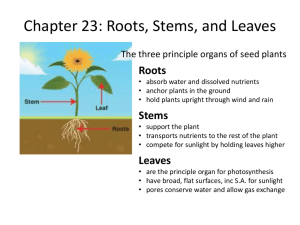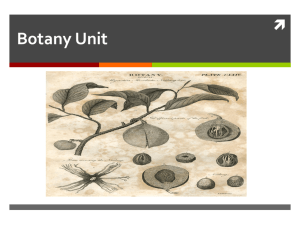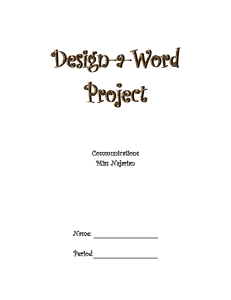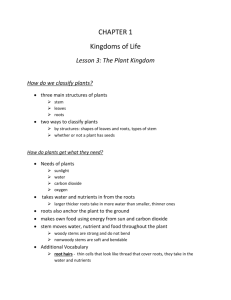how are plant bodies organized and how do they grow?
advertisement
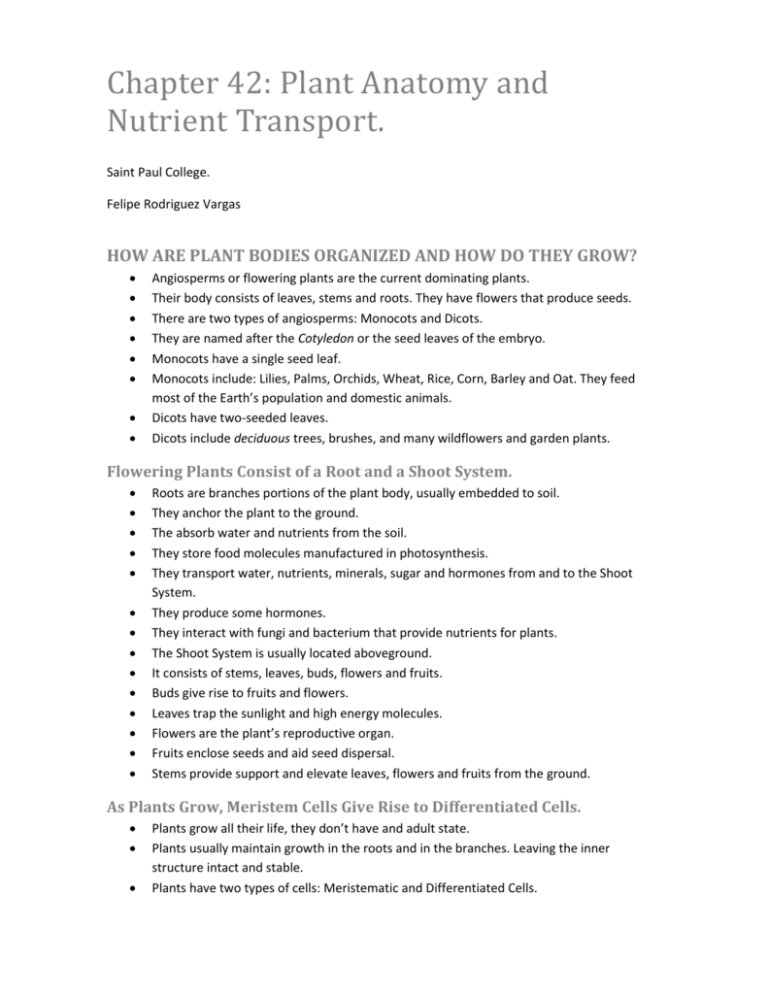
Chapter 42: Plant Anatomy and Nutrient Transport. Saint Paul College. Felipe Rodriguez Vargas HOW ARE PLANT BODIES ORGANIZED AND HOW DO THEY GROW? Angiosperms or flowering plants are the current dominating plants. Their body consists of leaves, stems and roots. They have flowers that produce seeds. There are two types of angiosperms: Monocots and Dicots. They are named after the Cotyledon or the seed leaves of the embryo. Monocots have a single seed leaf. Monocots include: Lilies, Palms, Orchids, Wheat, Rice, Corn, Barley and Oat. They feed most of the Earth’s population and domestic animals. Dicots have two-seeded leaves. Dicots include deciduous trees, brushes, and many wildflowers and garden plants. Flowering Plants Consist of a Root and a Shoot System. Roots are branches portions of the plant body, usually embedded to soil. They anchor the plant to the ground. The absorb water and nutrients from the soil. They store food molecules manufactured in photosynthesis. They transport water, nutrients, minerals, sugar and hormones from and to the Shoot System. They produce some hormones. They interact with fungi and bacterium that provide nutrients for plants. The Shoot System is usually located aboveground. It consists of stems, leaves, buds, flowers and fruits. Buds give rise to fruits and flowers. Leaves trap the sunlight and high energy molecules. Flowers are the plant’s reproductive organ. Fruits enclose seeds and aid seed dispersal. Stems provide support and elevate leaves, flowers and fruits from the ground. As Plants Grow, Meristem Cells Give Rise to Differentiated Cells. Plants grow all their life, they don’t have and adult state. Plants usually maintain growth in the roots and in the branches. Leaving the inner structure intact and stable. Plants have two types of cells: Meristematic and Differentiated Cells. Meristematic cells are able to divide by mitotic cell division. They haven’t reached an “adult” state in which they are assigned to do a specific “job”. Some of the “daughter” cells lose the ability to divide and become differentiated cells. They are assigned to “work” in the none growing part of the cell. So, Meristematic cells keep the plant growing whereas differentiated cells work in the non-growing portion of the plant. The Apical Meristem is a tissue located at the end of roots and shoots. The Lateral Meristem (also known as cambium) forms rings along the roots and stems. Plants have primary and secondary growth. Primary Growth occurs at the end of roots and shoots as apical Meristem cells divide and the resulting offspring differentiate. It is responsible for increasing length and specialized plant structures. Secondary Growth is responsible for diameter increase, occurs when lateral Meristem cells divide and their offspring differentiate. It makes roots and stems to become thicker as they age. Herbaceous plant only count with primary growth. They are annuals. (One year lifetime). Woody plants have both. They are perennials. (Many years lifetime). WHAT ARE THE TISSUES AND CELL TYPES OF PLANTS? When differentiated cells divide and work together to perform a specific function, they are called a tissue. Functional groups of more than one tissue are called tissue system. Plants have three tissue systems: Dermal Tissue System, which covers the surface of the plant body. Ground Tissue System, which makes up the body of young plants. Vascular tissue System, which transports fluids throughout the plant. The Dermal Tissue System Covers the Plant Body. There are two types of Dermal Tissue: Epidermal tissue and Periderm. Epidermis is the outermost layer that covers leaves, stems, roots, flowers, seeds and fruits. The aboveground epidermis is covered with a waxy cuticle, which controls evaporation and protects the plant from invading bacteria. Some epidermal cells produce some extensions called hairs. They enlarge the area for absorbing nutrients. They also prevent water loss. Some plants use it, in contrast, to hold water. Periderm, replaces epidermis in the roots and in the stems of woody plants. It is composed of cork cells, which die when they reach the maturity state and then harden and develop waterproof mechanisms. The Ground Tissue System Comprises Most of the Young Plant Body It consists of all the tissue that is not part of the Vascular or the dermal tissue. There are three types: Parenchyma, Collenchyma and Scelerenchyma. Parenchyma is the most abundant ground tissue; it carries the most of the plant’s metabolic activities. Some other functions are: photosynthesis, secretion of hormones, support and food storage. Collenchyma consists of polygonal cells. Their cell walls are somewhat flexible. In some plants they are an important source for support. They do not die. Scelerenchyma tissue is composed of secondary cell walls, which reinforce the stiffening agent lignin. They also provide support. These cells die after they differentiate, providing their body for more support and hardness. The Vascular Tissue System Transports Water and Nutrients. It consists of two complex conducting tissues: Xylem and Phloem. Xylem Conducts Water and Dissolved Minerals from Roots to the Rest of the Plant. Is composed of two types of cells: Tracheids and Vessel elements. They transport the nutrients and water from the roots to the shoots. Phloem Conducts Water, Sugars, Amino Acids and Hormones throughout the Plant Body. It is composed of sieve tube-elements and companion cells. It transports water, sugar, amino acids and hormones.
